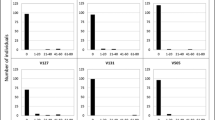Abstract
A retrospective study of the experiments performed during the past 15 years on infections of Galba truncatula with Fasciola hepatica was carried out to determine what susceptible populations of snails might be used for the commercial production of metacercariae, and to examine this metacercarial production in relation to the characteristics of snail infections. Of the four groups of snail populations studied, the ablest snails to sustain a complete larval development of F. hepatica originated from populations living on siliceous soils at 600 m and more in altitude. In contrast, snail populations living along river banks on siliceous soils were inappropriate due to the poor characteristics of snail infections (high snail mortality, low prevalence of snail infections, and low number of cercariae produced). Except for these last populations, 86–87% of cercaria-shedding (CS) snails in the other populations shed less than 300 cercariae, even if a maximum of 1,772 cercariae were obtained from a single snail. The date of the first cercarial shedding at 20°C began during week 7 or 8 PE for 80.1–83.5% of CS snails. Most metacercariae (82.0–85.9% of the total production) were recorded during the first 10 days of the patent period. In these conditions, the authors collected metacercarial production up to the beginning of week 10 PE (20°C) and did not use snails that shed their cercariae during the following weeks due to too low numbers of parasites. This method allows to have a continuous production of metacercariae over time by using successive groups of infected snails, each being separated from the other by a fortnight’s time.
Similar content being viewed by others
References
Abrous M, Roumieux L, Dreyfuss C, Rondelaud D, Mage C (1998) Proposition d’une technique simple pour la production métacercarienne de Fasciola hepatica Linné à partir du mollusque Lymnaea truncatula Müller. Rev Med Vet (Toul) 149:943–948
Augot D, Rondelaud D (2001) Cercarial productivity of Fasciola hepatica in Lymnaea truncatula during an usual or an unusual development of redial generations. Parasitol Res 87:631–633
Belfaiza M, Rondelaud D, Moncef M, Dreyfuss G (2004a) Fasciola hepatica: cercarial productivity of redial generations in long-surviving snails. J Helminthol 78:115–120
Belfaiza M, Abrous M, Rondelaud D, Moncef M, Dreyfuss G (2004b) The use of Tetraphyll® as food for snails increases the intensity of cercarial shedding in Galba truncatula infected with Fasciola hepatica. Parasitol Res 94:86–90
Boray JC (1969) Experimental fascioliasis in Australia. Adv Parasitol 7:95–210
Kendall SB (1949) Nutritional factors affecting the rate of development of Fasciola hepatica in Limnaea truncatula. J Helminthol 23:179–190
Kendall SB, Ollerenshaw CB (1963) The effect of nutrition on the growth of Fasciola hepatica in its snail host. Proc Nutr Soc 22:41–46
Ollerenshaw CB (1971) Some observations on the epidemiology of fascioliasis in relation to the timing of molluscicide application in the control of the disease. Vet Rec 88:152–164
Osborn GD, Gron N, Simmons D (1982) Maintenance and infection of the mud snail Lymnaea truncatula for Fasciola hepatica studies. J Inst Anim Tech 33:1–5
Prévéraud-Sindou M, Rondelaud D (1995) localization and outcome of Fasciola hepatica sporocysts in Lymnaea truncatula subjected to mono- or plurimiracidial exposures. Parasitol Res 81:265–267
Rondelaud D (1993) Variabilité interpopulationelle de l’infestation fasciolienne chez le mollusque Lymnaea truncatula Müller. Influence du contact préalable de la population avec le parasite. Bull Soc Zool Fr 118:185–193
Rondelaud D, Barthe D (1987) Fasciola hepatica L.: étude de la productivité d’un sporocyste en fonction de la taille de Lymnaea truncatula. Parasitol Res 74:155–160
Rondelaud D, Abrous M, Dreyfuss G (2002) The influence of different food sources on cercarial production in Lymnaea truncatula experimentally infected with Digenea. Vet Res 33:95–100
Rondelaud D, Denève C, Belfaiza M, Mekroud A, Abrous M, Moncef M, Dreyfuss G (2004) Variability in the prevalences of infections and cercarial production in Galba truncatula raised on a high quality diet. Parasitol Res 92:242–245
Stat-Itcf (1988) Manuel d’utilisation. Institut technique des céréales et des fourrages, Service des études statistiques, Boigneville
Vignoles P, Dreyfuss G, Rondelaud D (2002a) Larval development of Fasciola hepatica in experimental infections: variations with populations of Lymnaea truncatula. J Helminthol 76:179–183
Vignoles P, Favennec L, Dreyfuss G, Rondelaud D (2002b) Highland populations of Lymnaea truncatula infected with Fasciola hepatica survived longer under experimental conditions than lowland ones. Parasitol Res 88:386–388
Vignoles P, Favennec L, Rondelaud D, Dreyfuss G (2003) The experimental production of Fasciola hepatica metacercariae from three aquatic populations of Galba truncatula. J Helminthol 77:275–277
Vignoles P, Ménard A, Rondelaud D, Chauvin A, Dreyfuss G (2001) Fasciola hepatica: the characteristics of experimental infections in Lymnaea truncatula subjected to miracidia differing in their mammalian origin. Parasitol Res 87:945–949
Acknowledgement
The authors are grateful to Dr. M. Abrous for technical assistance.
Author information
Authors and Affiliations
Corresponding author
Rights and permissions
About this article
Cite this article
Dreyfuss, G., Alarion, N., Vignoles, P. et al. A retrospective study on the metacercarial production of Fasciola hepatica from experimentally infected Galba truncatula in central France. Parasitol Res 98, 162–166 (2006). https://doi.org/10.1007/s00436-005-0048-0
Received:
Accepted:
Published:
Issue Date:
DOI: https://doi.org/10.1007/s00436-005-0048-0




